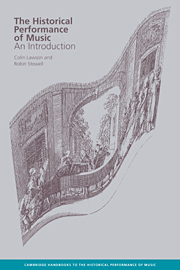2 - The application of primary sources
Published online by Cambridge University Press: 22 September 2009
Summary
Primary sources are the historical performer's raw material, the surviving evidence of past practices. In addition to composers' original autographs, sketches and drafts, evaluated later in connection with editions, the performer's primary source materials range from instrumental and theoretical treatises to surviving instruments, iconography, historical archives, references in literature, journals, newspaper reports, and sometimes even letters, diaries, catalogues, advertisements and, latterly, early recordings. This list could also be extended to include aspects of other art forms such as dance, some steps of which may have important implications for musical tempo. The relevance and significance of each of these source-groups inevitably varies according to the repertory to be performed, its period and geographical locality.
In order to realise the goal of historically informed performance, musicians need to collect, criticise, arrange, evaluate and interpret such raw material, which may be of very different origin, content, quality and purpose. Problems often arise, for example, in assessing a writer's background, his motives, his relation to his contemporaries, and his intended or actual readership; and it is rarely clear how widely most of any generation's music or treatises were known. The sources themselves are unreliable in varying degrees and may be self-contradictory or contradictory with one another in some respects and tiresomely repetitive in others. Nevertheless, either singly or as a group, they assist in building a picture and, once thoroughly evaluated, normally provide valuable information regarding the context or specifics of historical performance.
- Type
- Chapter
- Information
- The Historical Performance of MusicAn Introduction, pp. 17 - 41Publisher: Cambridge University PressPrint publication year: 1999



